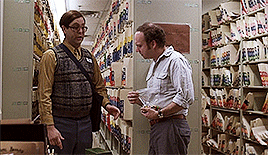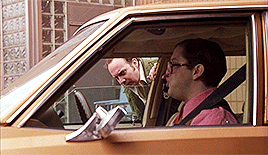#joyce brabner
Explore tagged Tumblr posts
Text
A pretty good appreciation of Joyce Brabner who made multiple contributions to indie comics throughout her life. As is always the case with artists married to more famous male artists, her own work was always overshadowed by Harvey Pekar. But Joyce did some fascinating stuff in her own right as a writer and editor.
#comics#Joyce Brabner#american splendour#I actually didn't realize she edited Brought to Light which I own! big miss by me!
4 notes
·
View notes
Text
JewCE 2024: American (Jewish) Splendor: Celebrating Harvey Pekar and Joyce Brabner
JewCE 2024: American (Jewish) Splendor: Celebrating Harvey Pekar and Joyce Brabner #jewce #jewce2024 #comics
Check put the panel “American (Jewish) Splendor: Celebrating Harvey Pekar and Joyce Brabner” from JewCE 2024. Harvey Pekar (1939-2010) created and wrote American Splendor comics, which inspired a whole branch of memoir comics (not to mention the 2003 American Splendor movie), which Harvey produced with Robert Crumb and other notable artists. With his wife and creative partner, Joyce Brabner, who…
#arie kaplan#comic books#Comics#danny fingeroth#dean haspiel#harvey pekar#jeff newelt#jewce#jewce: the jewish comics experience#josh neufeld#joyce brabner#peter kuper#video
0 notes
Text
Rest in peace, Joyce Brabner (March 1, 1952 – August 1, 2024)

Hope Davis as Joyce Brabner in American Splendor (2007).
Hope's five entries among my best 1001 movies are About Schmidt, The Matador, Infamous, Disconnect, and Rebel in the Rye.
11 notes
·
View notes
Text

January Wrap Up!
My favorite of the month was To Shape a Dragon's Breath by Moniquill Blackgoose, and Four Minutes by Nataliya Deleva translated by Izidora Angel and Banana Heart Summer by Merlinda Bobis checked off Bulgaria and the Philippines for my Read the World Challenge!
Soul Music by Terry Pratchett- 4⭐️
Homeland: My Father Dreams of Palestine by Hannah Moushabeck and Reem Madooh- 5⭐️
Mirrored Heavens by Rebecca Roanhorse- 5⭐️
Girlmode by Magdalene Visaggio and Paulina Ganucheau- 3⭐️
No. 6 Volume 4 by Atsuko Asano and Hinoki Kino- 3⭐️
Equal Rites by Terry Pratchett- 3⭐️
Spock: Reflections by Scott Tipton et al
Ten Myths About Israel by Illan Pappé- 4.5⭐️
Second Night Stand by Karelia and Fay Stetz-Waters- 4⭐️
Wicked: The Life and Times of the Wicked Witch of the West by Gregory Maguire- 2⭐️
Stars in Their Eyes by Jessica Walton and Aśka- 3⭐️
To Shape a Dragon's Breath by Moniquill Blackgoose- 5⭐️
Sanctuary by Paola Mendoza and Abby Sher- 5⭐️
Paper Planes by Jennie Wood and Dozerdraws- 3⭐️
A Short History of Trans Misogyny by Jules Gill-Peterson- 5⭐️
Doctor Who: The Eye of Torment by Scott Gray et al- 3⭐️
Life as a Unicorn: A Journey from Shame to Pride and Everything in Between by Amrou Al-Kadhi- 4.5⭐️
Uhura's Song by Janet Kagan- 2.5⭐️
Not the Israel My Parents Promised Me by Harvey Pekar, JT Waldman, and Joyce Brabner- 4⭐️
Redemptor by Jordan Ifueko- 4⭐️
A Map for Falasteen by Maysa Odeh and Aliaa Betawi- 5⭐️
Star Trek: The Next Generation/Doctor Who : Assimilation² Volume 1 by Scott and David Tipton et al- 4⭐️
For Laika: The Dog Who Learned the Names of the Stars by Kai Cheng Thom and Kai Yun Ching- 5⭐️
The Low, Low Woods by Carmen Maria Machado and DaNi- 4.5⭐️
Four Minutes by Nataliya Deleva trans by Izidora Angel- 1⭐️
Manhunt by Gretchen Felker-Martin- 3.5⭐️
Couplets by Maggie Millner- 3⭐️
The Art of Saving the World by Corrine Duyvis- 3⭐️
Star Trek: The Next Generation/Doctor Who : Assimilation² Volume 2 by Scott and David Tipton et al- 2.5⭐️
Banana Heart Summer by Merlinda Bobis- 5⭐️
3 notes
·
View notes
Text
Anniversari del Fumetto e dintorni, 1 marzo
Per i dettagli di ogni singola scheda fare click sul nome dalla pagina https://www.afnews.info/w22/anniversari/ Arnold Drake b.1924 Bast b.1974 Edmund Duffy b.1899 Frank Leclercq b.1967 George Kochell b.1957 Gos (Roland Goossens) b.1937 Irwin Donenfeld b.1926 Jack Oleck b.1914 Jeff Anderson, b.1956 Joanna Rubin Dranger, b.1970 Joyce Brabner b.1952 National Cartoonists Society formed 1946 Ralph…
0 notes
Text
544 WGCBP | License Renewed
This week on The World’s Greatest Comic Book Podcast™: We remember Joyce Brabner. There will be a Doctor Who – Star Trek crossover. A three day human trafficking sting operation was conducted at SDCC with 14 arrested and 10 victims rescued. In Tinsel Town: John Wick writer Derek Kolstad is adopting Ordained. Terry Matalas is the new showrunner for the Vision series. Deadpool and Wolverine…
#@Hold322#@JMBell#@jocechris#@sifujc#DC Comics#JC Carter#Jeff Bell#JM Bell#Jocelyn Christensen#Marvel Comics
0 notes
Text
Colin Kaepernick AI Company Blasted By Comics Pros, Joe Quesada Launches Amazing Comics, Joyce Brabner Dies | Comic Book Club News For August 5, 2024
Colin Kaepernick's new company Lumi is being obliterated by comic book pros for utilizing AI. Joe Quesada has launched a new comics company, Amazing Comics. Joyce Brabner, co-star of American Splendor, has died at 72.
Colin Kaepernick’s new company Lumi is being obliterated by comic book pros for utilizing AI. Joe Quesada has launched a new comics company, Amazing Comics. Joyce Brabner, co-star of American Splendor, has died at 72. All on Comic Book Club News for August 5, 2024. SUBSCRIBE ON RSS, APPLE, ANDROID, SPOTIFY, OR THE APP OF YOUR CHOICE. FOLLOW US ON TWITTER, INSTAGRAM, TIKTOK, AND FACEBOOK. SUPPORT…
0 notes
Text
Colin Kaepernick AI Company Blasted By Comics Pros, Joe Quesada Launches Amazing Comics, Joyce Brabner Dies | Comic Book Club News For August 5, 2024
Colin Kaepernick's new company Lumi is being obliterated by comic book pros for utilizing AI. Joe Quesada has launched a new comics company, Amazing Comics. Joyce Brabner, co-star of American Splendor, has died at 72.
Colin Kaepernick’s new company Lumi is being obliterated by comic book pros for utilizing AI. Joe Quesada has launched a new comics company, Amazing Comics. Joyce Brabner, co-star of American Splendor, has died at 72. All on Comic Book Club News for August 5, 2024. SUBSCRIBE ON RSS, APPLE, ANDROID, SPOTIFY, OR THE APP OF YOUR CHOICE. FOLLOW US ON TWITTER, INSTAGRAM, TIKTOK, AND FACEBOOK. SUPPORT…
0 notes
Photo










My Top 100 Favorite Movies:
95. American Splendor (2003) - Dir. Shari Springer Berman/Robert Pulcini
#American Splendor#Shari Springer Berman#Robert Pulcini#Paul Giamatti#Hope Davis#Judah Friedlander#James Urbaniak#Earl Billings#James McCaffrey#Maggie Moore#Harvey Pekar#Joyce Brabner#My Top 100 Favorite Movies#Top 100#My Gifs#My Post
27 notes
·
View notes
Photo

Someone kindly digitized a pretty hard to find political graphic anthology called 'Brought to Light: Thirty Years of Drug Smuggling, Arms Deals, and Covert Action' from 1988. I recommend giving them a read. "Shadowplay: The Secret Team written by Alan Moore and drawn by Bill Sienkiewicz with an introduction by Daniel Sheehan (general counsel of TCI). It covers the history of the Central Intelligence Agency and its controversial involvement in the Vietnam War, the Iran-Contra affair, and its relationship with figures like Augusto Pinochet and Manuel Noriega. The narrator of ‘Shadowplay’ is an aging anthropomorphic American Eagle, a bellicose retired CIA agent." .... "The story of ‘Shadowplay’ is of an unseen character (presumably representing the oblivious American public in first-person view of the reader) in a bar, where he is approached by a man-sized, walking, talking eagle. The eagle, from the emblem of the CIA, proceeds to drink alcohol and, in a drunken stupor, divulge all the bloody details of The Agency's sordid past. Early on a reference is made to the number of gallons an Olympic swimming pool can hold, and the fact that an adult human body has one gallon of blood; from then on, the victims of CIA activities (directly or indirectly) are quantified in swimming pools filled with blood, each pool representing 20,000 dead. Sienkiewicz's dark, erratic, and blurry images keep the mood of Moore's narration (through the boozing eagle) unnerving, and hazily nightmarish." .... "Flashpoint: The LA Penca Bombing is written by Joyce Brabner (and drawn by Thomas Yeates), as told to her by Christic Institute clients Martha Honey and Tony Avirgan. It deals with the La Penca bombing which happened during the civil war in Nicaragua in 1984."
For a more detailed account of how this anthology was made and the actual history involved that this anthology is only skimming, go here. For a wider view of the CIA’s involvement in drug trafficking and other illegal activities, see the wiki page ‘Allegations of CIA drug trafficking’ but consider it a primer on the subject rather than a comprehensive overview. Not my usual posting fair, I know.
#alan moore#bill sienkiewicz#brought to light#central intelligence agency#iran-contra affair#christic institute#joyce brabner#la penca bombing#tony avirgan#martha honey#tom yeates#thomas yeates
70 notes
·
View notes
Photo










American Splendor(2003)
#film#american splendor#paul giamatti#hope davis#shari springer berman#robert pulcini#harvey pekar#joyce brabner#...
2 notes
·
View notes
Photo






American splendor, 2003
#biography#comedy#drama#american splendor#shari springer berman#robert pulcini#harvey pekar#joyce brabner#paul giamatti#hope davis#dullness
12 notes
·
View notes
Text
Around the Tubes
Some comic news from around the web to start the day #comics #comicbooks
It’s a new week and we’re still sifting through San Diego Comic-Con, Otakon, and Gen Con and looking ahead at more conventions. While we get all that sorted, here’s some comic news from around the web to start the day. The Beat – Writer Joyce Brabner passes away at age 72 – Our thoughts are with her family, friends, and fans. Boing Boing – Star Wars back in theaters (in Ojibwe) – This is pretty…
0 notes
Photo

American Splendor (Shari Springer Berman/Robert Pulcini, 2003)
#american splendor#shari springer berman#robert pulcini#2003#film#movies#poster#faulty projector#harvey pekar#joyce brabner#paul giamatti#robert crumb#comic#comics#graphic novel#drama#comedy#indie#independent#biography#biopic
1 note
·
View note
Text
Not the Israel My Parents Promised Me by Harvey Pekar and JT Waldman, epilogue by Joyce Brabner
This is a graphic novel that interweaves the history of the Jewish people and Zionism with Pekar's own personal relationship to the philosophy, growing up with staunch Zionist parents in the 40s and 50s and slowly moving away from it in his adult life as he becomes more sympathetic to the Palestinians.
While reading, I was thinking how I was going to review it, and had been planning on saying something along the lines of "It's clearly constructed as a personal narrative, not a persuasive argument, because even being anti-Zionist myself, I'm still sitting here reading this like "Okay, well there's very obvious counter-arguments to some of the things you're saying that you aren't addressing at all."" And then I got to the end.
It's structured somewhat similarly to Maus in that we get modern scenes with the author showing the process of and conversations surrounding the research and construction of the book interspersed with historical and personal flashbacks. Pekar and Waldman are in a library, discussing Israel in the 80s and the arguments for and against a two state solution when they say that they'll pick up the conversation later. It then cuts to the epilogue by Pekar's wife discussing his death and funeral two years prior to the publishing of the book.
As such, I have to assume that what we have is a rough and unfinished first draft that Waldman and Brabner were left with after Pekar's death. The book is pretty clearly unfinished- it left out 30 years of Jewish history and we never got any sort of conversation with Pekar's parents that it felt like the book was leading to. But I can hardly fault the man for dying.
I'd say it's still worth a read- the graphic format makes the history very digestible, and an as anti-Zionist Jewish man raised by Zionist parents who is older than the state of Israel, Pekar has a unique and valuable perspective. But it is, ultimately, unfinished. If you're looking for Jewish anti-Zionist writing, I would recommend any of Ilan Pappé's work over this. 4⭐️
4 notes
·
View notes
Text
American Splendor (2003)
Comic Book Movies

Written & Directed by Shari Springer Berman & Robert Pulcini
Based on American Splendor by Harvey Pekar & Our Cancer Year by Harvey Pekar & Joyce Brabner
Starring Paul Giamatti & Hope Davis with Judah Friedlander, James Urbaniak, Earl Billings, & Madylin Sweeten
Release Date: August 15, 2003
Running Time: 1hr 41min
Rating: R

Plot (Spoilers):Harvey Pekar (Giamatti) is a…
View On WordPress
#American Splendor#blog#comic book movie#comics#film#Film Review#Geek#Harvey Pekar#Hope Davis#independent film#James Urbaniak#Joyce Brabner#Judah Friedlander#Madilyn Sweeten#Paul Giamatti#review#Robert Pulcini#Shari Springer Berman#Toby Radloff
0 notes